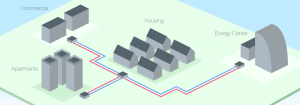Modern District Heating

District heating
Modern district heating (DH) is actually more than 100 years old. Modern DH started around the turn of the 20th century n Moscow, Frederiksberg, and Copenhagen. It’s used in European nations, Russia, and China to a more significant degree today than in the rest of the world, however, district heating has risen in popularity and use throughout much of the rest of the world.
District heating is also known as "district energy", as there are district systems that can provide both heating and cooling. Using district cooling, like district heating, is more cost-efficient and fuel-efficient than traditional heating, ventilation, and air-conditioning (HVAC).
District energy has proven its effectiveness in improving energy efficiency for buildings primarily throughout Europe and Asia, although these systems are gaining ground in the rest of the world, as well. Here is a chart that illustrates where district heating and cooling is found, and information on what sector it's used for-

In this article, the focus is on district heating, which like district cooling, is more efficient than conventional HVAC. Please note that:
"The cold deliveries from district cooling systems are much smaller than heat deliveries from district heating systems." [quote from - sciencedirect.com]
DH is generally implemented when a municipality makes use of otherwise wasted heat. DH uses excess heat from a power plant to create heat for buildings or homes in a city by sending the heat (usually in the form of heated water, steam, or gas) through insulated pipes to homes and buildings to be used as space or water heating.
Heat and energy for district heating are often derived from the use of excess heat from energy generation in combined heat and power (CHP) plants. District heating systems using cutting-edge technologies were designed and introduced in the 1980s (with constant breakthroughs since then)-- with automatic control, remote monitoring, and unmanned operations.
District heating explained
For any modern city with a dense population, a district heating supply offers the most significant contribution to ensuring energy efficiency that's readily available (as discussed in this UN Environment article). District heating is used in many large and small cities across Europe, but needs to be used more in major cities throughout the world.
Please also see: Improving Energy Efficiency